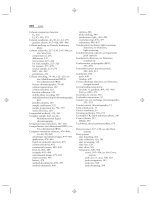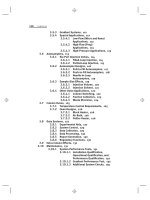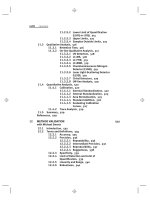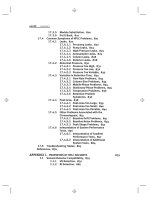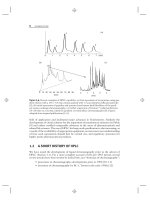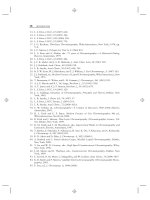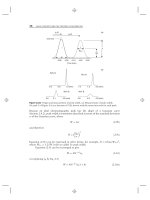Introduction to Modern Liquid Chromatography, Third Edition part 6 pps
Bạn đang xem bản rút gọn của tài liệu. Xem và tải ngay bản đầy đủ của tài liệu tại đây (207.7 KB, 10 trang )
6 INTRODUCTION
01234567
(min)
(
min
)
#7
(b) (c)
(a)
1
2
3
4
5
6
0102030405060708090
01234
(sec)
Figure 1.4 Recent examples of HPLC capability. (a) Fast separation of six proteins, using gra-
dient elution with a 150 × 4.6-mm column packed with 1.5-μm-diameter pellicular particles
[5]; (b) initial separation of peptides and proteins from human fetal fibroblast cell by gradi-
ent cation-exchange chromatography; (c) further separation of fraction 7 (collected between
24–28 min) on a second column by gradient reversed-phase chromatography [6]. Figures
adapted from original publications [5, 6].
field of application and facilitated major advances in biochemistry. Similarly the
development of chiral columns for the separation of enantiomeric mixtures by Pirkle
[9] and others enabled comparable advances in the areas of pharmaceuticals and
related life sciences. The use of HPLC for large-scale purification is also increasing, as
a result of the availability of appropriate equipment, an increase in our understanding
of how such separations should best be carried out, and regulatory pressures for
higher purity pharmaceutical products.
1.2 A SHORT HISTORY OF HPLC
We have noted the development of liquid chromatography prior to the advent of
HPLC (Section 1.1). For a more complete account of this pre-1965 period, several
review articles have been written by Leslie Ettre, our ‘‘historian of chromatography’’:
• precursors to chromatography; developments prior to 1900 [10, 11]
• invention of chromatography by M. S. Tswett in the early 1900s [12]
1.2 A SHORT HISTORY OF HPLC 7
• rediscovery of chromatography in the early 1930s [13]
• A. J. P. Martin’s invention of partition and paper chromatography in the
early 1940s [14]
• development of the amino-acid analyzer by S. Moore and W. S. Stein in the
late 1950s [15]
• development of the gel-permeation chromatograph by Waters Associates in
the early 1960s [16]
Carl Runge, a German dye-chemist born in 1856, first reported crude dye
separations by means of a technique similar to paper chromatography [10], but
neither he nor others pursued the practical possibilities of this work. In the late
1890s David Day at the US Geological survey carried out separations of petroleum by
a technique that resembles classical column chromatography [11]; however, his goal
was not the development of a separation technique, but rather the demonstration that
petroleum deposits of different quality result from their separation during migration
through the ground. As in the case of Runge’s work, Day’s investigations did
not proceed further. In the early 1900s, Mikhail Tswett invented classical column
chromatography and demonstrated its ability to separate different plant extracts
[12]. This was certainly the beginning of chromatography, but the value of his work
was not appreciated for another two decades. In the early 1930s, Tswett’s work was
rediscovered [13], leading to an explosive subsequent growth of chromatography.
The invention of paper chromatography by A.J.P. Martin followed in 1943 [14],
accompanied by the development of thin-layer chromatography between the late
1930s and the mid-1950s [17]. This short summary necessarily omits numerous
other contributions to the development of chromatography before 1955.
The amino-acid analyzer, introduced in the late 1950s [15], was an important
precursor to HPLC; it was an automated means for analyzing mixtures of amino
acids by use of ion-exchange chromatography (Section 7.5). This was followed by
the invention of gel permeation chromatography (Section 13.7) by Moore [18] and
the introduction in the early 1960s of a gel-permeation chromatograph by Waters
Associates [16]. Each of these latter techniques was close in concept to what later
became HPLC, differing little from the schematic of Figure 1.1g. In each case the
solvent was pumped at high pressure through a reusable, small-particle column,
the column effluent was continuously monitored by a detector, and the output of
the device was a chromatogram as in Figure 1.1h. What each of these two systems
lacked, however, was an ability to separate and analyze other kinds of samples.
The amino-acid analyzer was restricted to the analysis of mixtures of amino acids,
while the gel-permeation chromatograph was used exclusively for determining the
molecular weight distribution of synthetic polymers. In neither case were these
devices readily adaptable for the separation of other samples.
During the early 1960s, two different groups embarked on the development
of a general-purpose HPLC system, under the leadership of Csaba Horv
´
athinthe
United States and Josef Huber in Europe. Each of these two men have described
their early work on HPLC in a collection of personal recollections [19], and Ettre
has provided additional detail on early work in Horv
´
ath’s laboratory [20]. The
immediate results of these two groups, plus related work by others that was carried
out a few years later, are described in publications that appeared in 1966 to 1968
[2, 21–24]. The introduction of commercial equipment for HPLC followed in the
8 INTRODUCTION
late 1960s, with systems from Waters Associates and DuPont initially dominating
the market. Other companies soon offered competing equipment, and research on
HPLC began to accelerate (as seen from Fig. 1.2a). By 1971, the first HPLC book
had been published [25], and an HPLC short course was offered by the Ameri-
can Chemical Society (Modern Liquid Chromatography), with J. J. Kirkland and
L. R. Snyder as course instructors).
Progressive improvements in HPLC from 1960 to 2010 are illustrated by the
representative separations of Figure 1.5a–f , which show separation times decreasing
by several orders of magnitude during this 50-year interval. Figure 1.5g shows how
this reduction in separation time (
◦
,—) was related to increases in the pressure drop
across the column (- - -) and a reduction in the size of particles (
•
)thatwereusedto
pack the column. In the early days of HPLC the technique was sometimes referred to
as ‘‘high-pressure liquid chromatography’’ or ‘‘high-speed liquid chromatography,’’
for reasons suggested by Figure 1.5g. Figure 1.5h shows corresponding changes in
column length (
•
) and flow rate (
◦
) for the separations of Figure 1.5a–e.
A theoretical foundation for the eventual development of HPLC was established
well before the 1960s. In 1941, Martin reported [27] that ‘‘the most efficient columns
should be obtainable by using very small particles and high-pressure differences
across the length of the column;’’ this summarized the requirements for HPLC
separation in a nutshell (as demonstrated by Fig. 1.5g). In the early 1950s, the
related technique of gas chromatography was invented by Martin [28]; its rapid
acceptance by the world [29] led to a number of theoretical studies that would prove
relevant to the later development of HPLC. Giddings summarized and extended this
work for specific application to HPLC in the early 1960s [30], work that was later to
prove important for both column design and the selection of preferred experimental
conditions.
For a further background on the early days of HPLC, see [19, 31–33].
Additional historical details on the progress of HPLC after 1980 are provided by
the collected biographies of several HPLC practitioners [34].
1.3 SOME ALTERNATIVES TO HPLC
Two, still-important techniques, each of which can substitute for HPLC in certain
applications, existed prior to 1965: gas chromatography (GC) and thin-layer chro-
matography (TLC). Countercurrent chromatography (CCC) is another pre-1965
technique that, in principle, might compete with HPLC in many applications but
falls considerably short of the speed and separation power of HPLC. Several addi-
tional, potentially competitive, techniques were introduced after HPLC: supercritical
fluid chromatography (SFC) in the 1970s, capillary electrophoresis (CE) in the 1980s,
and capillary electrochromatography (CEC) in the 1990s.
1.3.1 Gas Chromatography (GC)
Because GC [35] is limited to samples that are volatile below 300
◦
C, this technique
is not applicable for very-high-boiling or nonvolatile materials. Thus about 75%
of all known compounds cannot be separated by GC. On the other hand, GC
is considerably more efficient than HPLC (higher values of the plate number N),
1.3 SOME ALTERNATIVES TO HPLC 9
02 46 8
01020304050
(hr)
(min)
(a) (b)
0 2 4 6 8 10 12 0 1 2 3 4 5
(min) (min)
1960 (pre-HPLC)
1970 (HPLC)
1980 1990
2000 2010
0 0.5 1.0 1.5 2.0 0 0.2 0.4 0.6 0.8 1.0
(min) (min)
(c) (d)
(e) (f)
Figure 1.5 Representative chromatograms that illustrate the improvement in HPLC perfor-
mance over time. Sample: five herbicides. Conditions: 50% methanol-water, ambient tem-
perature. Chromatograms a–f are DryLab
R
computer simulations (Section 10.2), based on
data of [26]; g and h provide details for the separations of a–f . Column-packings of identical
selectivity and 4.6-mm-diameter columns are assumed.
which means faster and/or better separations are possible. GC is therefore preferred
to HPLC for gases, most low-boiling samples, and many higher boiling samples
that are thermally stable under the conditions of separation. GC also has available
several very sensitive and/or element-specific detectors that permit considerably
lower detection limits.
1.3.2 Thin-Layer Chromatography (TLC)
The strong points of TLC [36] are its ability to separate several samples simul-
taneously on a single plate, combined with the fact that every component in the
sample is visible on the final plate (strongly retained compounds may be missed in
10 INTRODUCTION
10,000
1,000
100
10
1
100-μm particles
30-μm
10-μm
5-μm
3-μm
1.5-μm
Pressure (psi)
Run time (min)
(g)
(h)
100
10
1
0.1
Length (cm)
Flow rate (mL/min)
1960 1980 1990 2000 20101970
1960 1980 1990 2000 20101970
Figure 1.5 (Continued)
HPLC). With the advent of specialized equipment for the pressurized flow of solvent
across the plate, so-called high-performance TLC (HP-TLC) has become possible.
Regardless of how it is carried out, however, TLC lacks the separation efficiency of
HPLC (as measured by values of N), and quantitation is less convenient and less
precise. At the time of publication of the present book, TLC was used relatively
infrequently in the United States for quantitative analysis, although it is a convenient
means for semi-quantitative analysis and for the detection of sample impurities. It
is widely used for screening large numbers of samples, with little need for sample
cleanup (e.g., plasma drug screening). In Europe HP-TLC is more popular than in
the United States but much less popular than HPLC.
1.3.3 Supercritical Fluid Chromatography (SFC)
SFC [37] is carried out with equipment and columns that are similar to HPLC.
The solvent is, by definition, a supercritical fluid, usually a gas such as CO
2
,
1.3 SOME ALTERNATIVES TO HPLC 11
under conditions of elevated pressure and temperature. SFC can be regarded as an
extension of GC, in that supercritical fluids can dissolve and separate samples that
are normally considered to be nonvolatile. SFC may be considered as a hybrid of
GC and HPLC, as it is characterized by greater separation efficiency than for HPLC
(higher N) but lower efficiency than GC. Similarly the solvent in SFC plays a greater
role in determining separation than in GC, but less so than in HPLC. Detection
sensitivity is also intermediate between what is possible with HPLC compared to
GC. A major application of SFC is for the analysis of natural or synthetic polymeric
mixtures, for example, the separation of polyphenols as described in [38]. Whereas
HPLC may be unable to resolve individual polymeric species with molecular weights
above some maximum value, SFC can usually extend this upper molecular-weight
limit considerably. SFC has also been used for separating enantiomers, whose very
similar retention may require greater separation efficiency (larger value of N).
1.3.4 Capillary Electrophoresis (CE)
CE [1, 39] is not a form of chromatography, but it competes effectively with HPLC
for the separation of certain classes of compounds. The principle of separation is
the differential migration of sample compounds in a capillary, under the influence
of an electric field, with the result that compounds are separated on the basis
of their mass-to-charge ratio (m/z); compounds with smaller m/z migrate faster.
Consequently compounds that are to be separated by CE must carry an ionic charge.
CE is characterized by a greater separation efficiency than for HPLC (higher value of
N), especially for the separation of compounds of high molecular weight. However,
detection sensitivity is usually much poorer than for HPLC. CE is heavily used for the
genomic analysis of various species, based on the fractionation of DNA fragments.
CE has also proved popular for analytical separations of enantiomeric samples, where
its performance may exceed that of HPLC for two reasons. First, these separations
are often difficult and therefore are facilitated by the larger values of N available
from CE. Second, HPLC separations of enantiomers usually rely on chiral columns.
The separation of a particular enantiomeric sample may require the trial-and-error
testing of several different (and expensive) columns before a successful separation
is achieved. CE allows the use of small amounts of different chiral complexing
agents—instead of different columns, allowing for a faster, cheaper, and more
versatile alternative to HPLC. The required flow rates for HPLC compared with
CE (e.g., mL/min vs. μL/min) make the use of costly chiral complexing reagents
impractical for HPLC. Several variations of CE exist, which allow its extension
to other sample types; for example, non-ionized compounds can be separated by
micellar electrokinetic chromatography [40].
1.3.5 Countercurrent Chromatography
CCC [41, 42] is an older form of liquid–liquid partition chromatography that was
later improved in various ways. HPLC with a liquid stationary phase was since
replaced by bonded-phase HPLC, the use of CCC as an alternative to HPLC has
become relatively less frequent. An often-cited feature of CCC is its freedom from
problems caused by irreversible attachment of the sample to the large internal
surface present in HPLC columns. However, the improved HPLC columns used
today are largely free from this problem. CCC may possess certain advantages for
12 INTRODUCTION
the preparative separation of enantiomers [43]; otherwise, the technique is used
mainly for the isolation of labile natural products.
1.3.6 Special Forms of HPLC
The five separation techniques mentioned above (Sections 1.3.1–l.3.5) differ in
essential ways from HPLC. Four other procedures, which will not be discussed in
this book, can be regarded as HPLC variants. However, much of the information in
following chapters can be adapted for use with the following procedures.
Capillary electrochromatography [44, 45] (CEC) is generally similar to HPLC,
except that the flow of solvent is achieved by means of an electrical potential across
the column (endoosmotic flow), rather than by use of a pump. Because solvent flow
is not affected by the size of particles within the column (and column efficiency can
be greater for small particles), much larger values of N are, in principle, possible
by means of CEC. Higher values of N also result from endoosmotic flow per se.
Because of these potentially greater values of N in CEC than in HPLC, considerable
effort has been invested since 1995 into making this technique practical. However,
major technical problems remain to be solved, and CEC had not become a routine
alternative to HPLC at the time this book went to press.
HPLC on a chip [46] is a recently introduced technology for the convenient
separation of very small samples. A micro-column (e.g., 43 × 0.06 mm) forms part
of the chip, which can be interfaced between a micro pump and a mass spectrometer.
The principles of separation are the same as for HPLC with conventional columns
and equipment, but a chip offers advantages in terms of separation power and
convenience for very small samples.
Ion chromatography [47, 48] is widely used for the analysis of mixtures that
contain inorganic anions and cations; for example, Cl
−
and Na
+
, respectively. While
the principles of separation are the same as for ion-exchange HPLC (Section 7.5),
ion chromatography involves special equipment and is used mainly for inorganic
analysis.
Micellar liquid chromatography is a variant of reversed-phase chromatography
in which the usual aqueous-organic solvent is replaced by an aqueous surfactant
solution [49]. It is little used at present because of the lower efficiency of these
separations.
1.4 OTHER SOURCES OF HPLC INFORMATION
A wide variety of resources is available that can be consulted to supplement
the use of the present book. These include various other publications (Sections
1.4.1–1.4.3), short courses (Section 1.4.4), and the Internet (Section 1.4.5).
1.4.1 Books
Literally hundreds of books on chromatography have now been published, as
reference to Amazon.com and other internet sources can readily verify. Books on
HPLC can be divided into two groups: (1) specialized texts that address the HPLC
separation of a certain kind of sample (e.g., proteins, carbohydrates, enantiomers),
1.4 OTHER SOURCES OF HPLC INFORMATION 13
or by means of special detection (e.g., mass spectrometer, chemical derivatization),
and (2) more general books, such as the present book, that cover all aspects of HPLC.
Specialized HPLC books are referenced in later chapters that address different HPLC
topics. Table 1.1 provides a partial listing of more general HPLC books published
after 1995 that might serve as useful supplements to the present book.
1.4.2 Journals
Technical articles that involve HPLC can appear in most journals that deal with the
chemical or biochemical sciences. However, the journals below are of special value
to those readers wishing to keep abreast of new developments in the field.
• Analytical Chemistry, American Chemical Society
• Chromatographia,Springer
• Journal of Chromatographic Science, Preston
• Journal of Chromatography A, Elsevier
• Journal of Chromatography B, Elsevier
• Journal of Liquid Chromatography, Wiley
• Journal of Separation Science, Wiley
• LCGC, Advanstar (separate issues for North America and Europe)
1.4.3 Reviews
Review articles that deal with HPLC can be found in the journals listed above and
in other journals. Additionally there are series of publications that are devoted in
part to HPLC, either as collections of review articles
• Advances in Chromatography, Dekker
• High-Performance Liquid Chromatography. Advances and Perspectives,
Academic Press (published only between 1980 and 1986)
or as individual books:
• Journal of Chromatography Library, Elsevier
1.4.4 Short Courses
There are numerous short courses offered either ‘‘live’’ or on the Internet (see
Section 1.4.5). For a current listing of short courses, see the back pages of LCGC
magazine or search the Internet for ‘‘HPLC training.’’
1.4.5 The Internet
The dynamic nature of the Internet ensures that any listing in a book will soon be
obsolete. A number of sites are links to other sites and, as such, presumably will be
continuously updated:
/>14 INTRODUCTION
Table 1.1
Some HPLC Books of General Interest Published since 1995
Title Author(s) Publication Publisher
Date
General texts
Handbook of HPLC E.Katz,R.Eksteen,
P. Schoenmakers,
and N. Miller, eds.
1998 Dekker
High Performance
Liquid
Chromatography
S. Lindsay 2000 Wiley
High Performance
Liquid
Chromatography
E. Prichard 2003 Royal Society of Chemistry
HPLC, 2nd ed. M.C. McMaster 2006 Wiley-Interscience
Modern HPLC for
Practicing Scientists
M. W. Dong 2006 Wiley-Interscience
Practical High-
Performance Liquid
Chromatography,
4th ed.
V. R. Meyer 2006 Wiley-Interscience
Method development
Practical HPLC
Method
Development, 2nd
ed.
L. R. Snyder,
J. L. Glajch, and
J. J. Kirkland
1997 Wiley-Interscience
HPLC Made to
Measure: A
Practical Handbook
for Optimization
S. Kromidas 2006 Wiley
Troubleshooting
LC Troubleshooting J.W. Dolan 1983–
present
Monthly column in LCGC Magazine;
past columns available at
www.chromatographyonline.com
Troubleshooting
HPLC Systems: A
Bench Manual
P. C. Sadek 1999 Wiley
More Practical
Problem Solving in
HPLC
S. Kromidas 2005 Wiley
Pitfalls and Errors of
HPLC in Pictures
2nd ed.
V. R. Meyer 2006 Wiley
REFERENCES 15
Table
1.1
(Continued)
Title Author(s) Publication Publisher
Date
Preparative HPLC
Practical Handbook of
Preparative HPLC
D. A. Wellings 2006 Elsevier
HPLC columns
HPLC Columns:
Theory, Technology
and Practice
U. D. Neue 1997 Wiley-VCH
HPLC solvents
The HPLC Solvent
Guide
P. C. Sadek 1996 Wiley
Gradient elution
High-Performance
Gradient Elution
L. R. Snyder and
J. W. Dolan
2007 Wiley
/>thtp://tech.groups.yahoo.com/group/chrom-L/links
/> />chromat.html
REFERENCES
1. R. L. Cunico, K. M. Gooding, and T. Wehr, Basic HPLC and CE of Biomolecules,Bay
Bioanalytical Laboratory, Richmond, CA, 1998, p. 4.
2. C. G. Horv
´
ath and S. R. Lipsky, Nature, 211 (1966) 748.
3. I. Halasz, R. Endele, and J. Asshauer, J. Chromatogr., 112 (1975) 37.
4. I. Molnar and C. Horv
´
ath, J. Chromatogr. (Biomed App.), 143 (1977) 391.
5. T. Issaeva, A. Kourganov, and K. Unger, J. Chromatogr. A, 846 (1999) 13.
6. K. Wagner, T. Miliotis, G. Marko-Varga, R. Biscoff, and K. Unger, Anal. Chem.,74
(2002) 809.
7. S. H. Chang, K. M. Gooding, and F. E. Regnier, J. Chromatogr., 125 (1976) 103.
8. W. W. Hancock, C. A. Bishop, and M. T. W. Hearn, Science, 153 (1978) 1168.
9. W. H. Pirkle, D. W. House, and J. M. Finn, J. Chromatogr., 192 (1980) 143.
10. H. H. Bussemas and L. S. Ettre, LCGC, 22 (2004) 262.
11. L. S. Ettre, LCGC, 23 (2005) 1274.
12. L. S. Ettre, LCGC, 21 (2003) 458.
